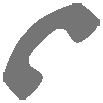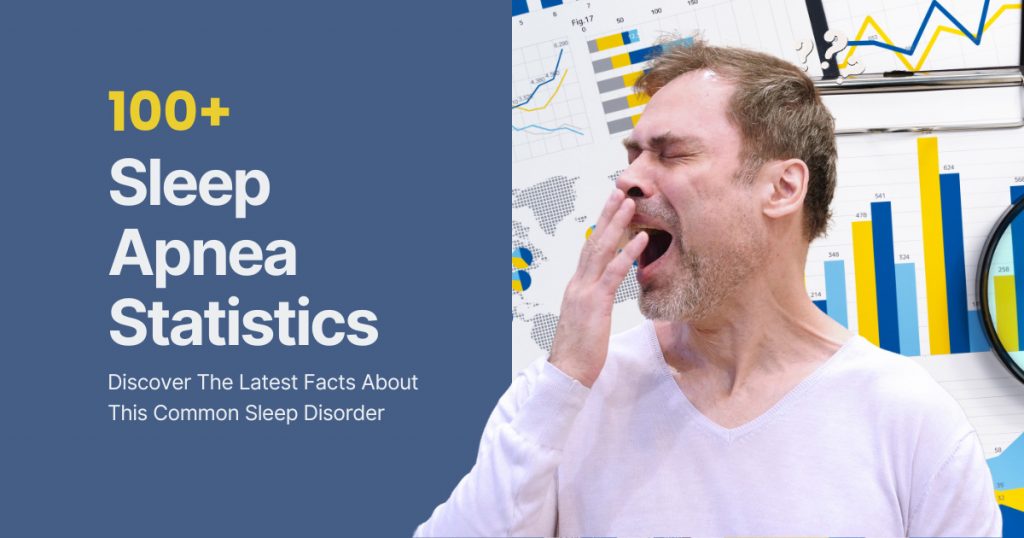
Sleep apnea is the second most common sleep disorder in the world, and health experts are becoming more concerned about its effects as our population ages. To better understand and illustrate the impact of this growing epidemic, we’ve compiled the collection of sleep apnea statistics you’ll find below.
We’ll look at its prevalence, who it affects most, and how it impacts us both in the short and long term. We’ll also provide you with several CPAP statistics, including how many people use CPAP and its success rate. Lastly, we’ll examine the numbers behind alternative methods for treating sleep apnea.
How Many People Have Sleep Apnea?
Recent estimates suggest nearly 1 billion people have sleep apnea worldwide, with 936 million cases of Obstructive Sleep Apnea alone. US officials estimate more than 30 million Americans are affected, though the majority are undiagnosed.
United States
- According to the American Medical Association, it is believed that more than 30 million people have sleep apnea in the US.
- It’s estimated that at least 9% of the US population has this sleep-breathing disorder.
- It’s believed that there are nearly 24 million cases of undiagnosed sleep apnea in the US alone.
- Only 6 million cases have actually been diagnosed in the US.
- In the United States, sleep apnea is as common as diabetes and more common than asthma.
Related Reading: How Americans Experience Sleep Apnea
North America
- It’s estimated that 10-15% of women are affected by sleep apnea in North America.
- Those same estimates suggest that 15-30% of men in North America have it as well.
- Experts believe that 15-30% of commercial drivers in North America have sleep apnea.
- There are approximately 170 million people in both the Americas with sleep apnea, and this is considered to be a conservative estimate.
Related Reading: Prevalence of Sleep Apnea in the Americas
Globally
- It is estimated that at least 936 million people have OSA globally.
- Up to 425 million people worldwide could have at least moderate Obstructive Sleep Apnea.
- One study estimated that 0.9% of adults may have CSA, which amounts to just under 80 million people globally.
- It’s approximated that 80 to 90% of cases of sleep apnea go undiagnosed.
- Reports suggest that over one in seven adults have OSA worldwide.
- The prevalence of sleep apnea in South Korea is similar to that of the USA despite lower rates of obesity.
- A large study in Russia found that nearly half of Russian adults between the ages of 30 and 70 had at least mild Obstructive Sleep Apnea.
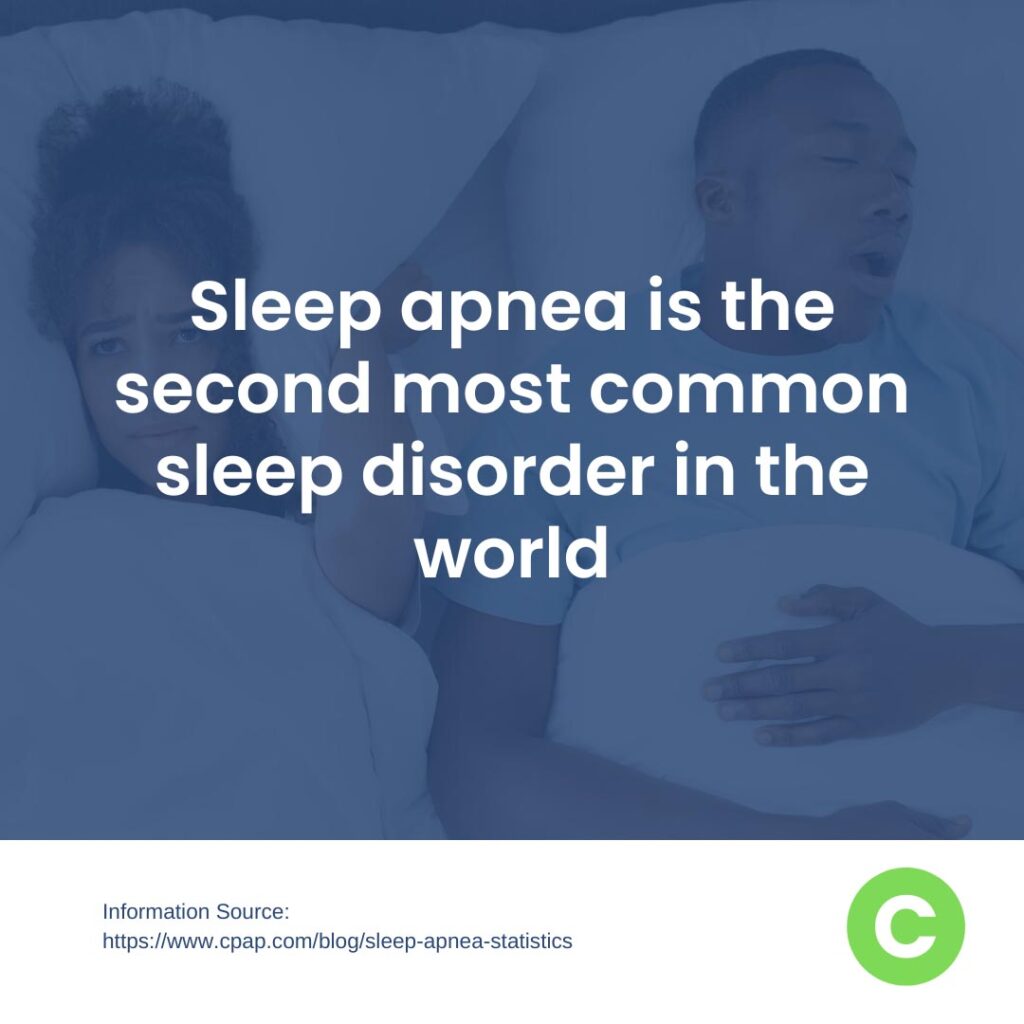
Demographics of Sleep Apnea
Sleep-disordered breathing is much more common in older men. However, there are many types of people with a higher risk for sleep apnea, including certain races, those who are overweight, people with chronic disease or weakened health, and those who use cigarettes, alcohol, or drugs.
Sex/Gender
- Sleep apnea impacts more than twice as many men than women.
- Severe sleep apnea is more common in men.
- Women are more likely to report generalized symptoms of sleep apnea like headache, fatigue, mental health changes, or insomnia.
- Men are more likely to report more specific sleep apnea symptoms such as snoring, choking at night, or waking up gasping for air.
- Menopause increases a woman’s risk of developing sleep apnea.
- Women with sleep apnea may be more impacted in their day-to-day lives.
- Male cases are more likely to develop cardiovascular disease.
Related Reading: Signs of Sleep Apnea in Men, Signs of Sleep Apnea in Women, Low Testosterone and Sleep Apnea, & How Menopause Affects Sleep
Age
- People over 65 are twice as likely to be impacted compared to middle-aged adults.
- Around 50% of people over 65 may have at least mild sleep apnea.
- 20% of people 65 and over may have moderate to severe sleep apnea.
- Aging may have a bigger impact on women with this condition than men.
- It is estimated that between 1 and 6% of children have OSA.
- Between 1 and 5% of children have CSA.
Related Reading: Sleep Apnea in Children
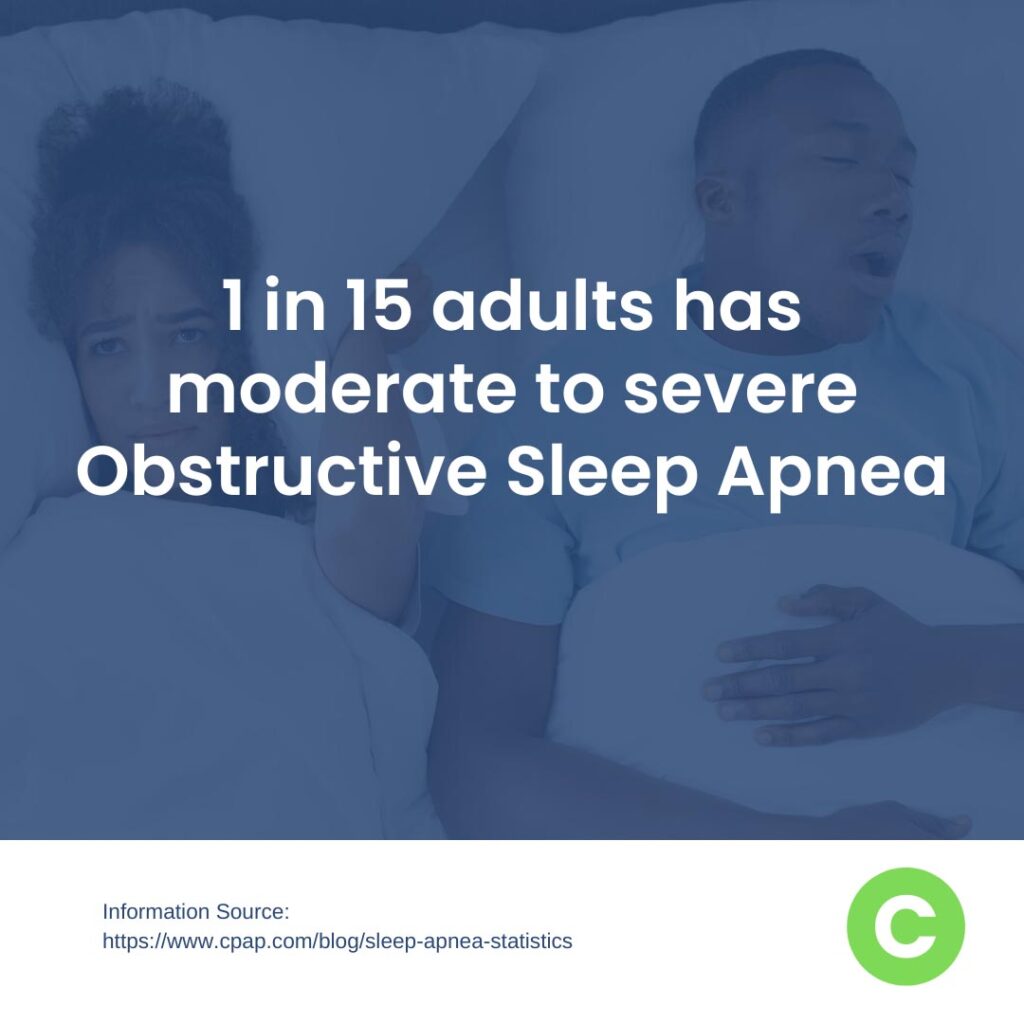
Race
- When all other factors are accounted for, Asians have a higher risk for sleep apnea. This is most likely due to slight anatomical differences.
- African Americans, Native Americans, and Hispanics also have an increased risk, but it’s thought to be due to a predisposition for obesity.
- African Americans are more likely to develop sleep apnea-related high blood pressure.
- Hispanic people with sleep apnea are more likely to report snoring.
Related Reading: Sleep Apnea Is Influenced by Race
Weight
- It affects about 40% of people with obesity.
- Around 20% of obese people with Obstructive Sleep Apnea/Hypopnea Syndrome also have Obesity-Hypoventilation Syndrome.
- Between 15 and 20% of obese pregnant women will develop this condition.
- As you age, BMI becomes less of a contributor to your sleep apnea risk.
Related Reading: Sleep Apnea and Weight & Alcohol, Weight Gain, and Sleep Apnea
Medical Conditions
- It is estimated that more than 1/4th of all pregnant women will experience sleep apnea during the third trimester.
- Certain medications have been proven to trigger this condition, including benzodiazepines, narcotic pain relievers, muscle relaxers, and some male hormones.
- CSA can be caused by Congestive Heart Failure (CHF). An estimated 40% of people with CHF also have CSA.
- Experts have estimated that 40% of your sleep apnea AHI score is determined by genetic factors.
- It often affects people with neurodegenerative diseases. Up to 40% of people with Parkinson’s Disease have sleep apnea.
Related Reading: Pregnancy and Sleep Apnea, Can Sleep Apnea Be Hereditary?, & Sleep Apnea and COPD
Habits
- If you are a heavy drinker, your risk increases by 25%.
- The Wisconsin Sleep Cohort Study found that people who currently smoked had a 340% greater chance of developing sleep apnea than nonsmokers.
- While the numbers vary, studies show that chronic use of opioid drugs can significantly increase your risk of OSA and CSA.
Related Reading: Sleep Apnea and Alcohol, Sleep Apnea and Smoking, & How Drugs and Alcohol Impact Sleep Apnea
Signs and Symptoms of Sleep Apnea
A sleep disorder can have many negative effects on your well-being, and it is important to remember that each person has a unique experience when it comes to sleep apnea. Often, mild sleep apnea is associated with fewer symptoms, while severe cases can be debilitating.
Snoring
- While snoring doesn’t happen to everyone, an estimated 94% of cases of OSA involve snoring.
- According to the Journal of Clinical Sleep Medicine, louder snoring is linked to more severe cases.
- Snoring usually disturbs other people as well. In one study, 55% of sleep apnea partners said their sleep was impacted every night due to the other person’s snoring.
Related Reading: Difference Between Sleep Apnea and Snoring, Does CPAP Therapy Stop Snoring?, Why You May Still Be Snoring WIth CPAP, & Does My Partner Have Sleep Apnea?
Poor Sleep
- Those with sleep apnea often score higher on the Epworth Sleepiness Scale.
- People with mild cases can experience dozens of sleep disturbances each night.
- People with severe sleep apnea can experience hundreds of sleep disturbances per night. In some instances, it may be more than a hundred per hour.
- In one study, 87% of people reported that their restless sleep improved after six months of CPAP therapy.
- Up to 58% of cases report experiencing excessive daytime sleepiness when first diagnosed.
Related Reading: Signs of Sleep Apnea if You’re Feeling Tired, Why Am I Still Tired After CPAP Therapy, & Sleep Apnea and Insomnia
Headaches
- Researchers have estimated that more than 30% of people with OSA experience morning headaches.
- Up to 90% of people who experience these headaches report improvement after starting CPAP treatment.
Related Reading: Sleep Apnea Headaches
Brain Fog
- While exact numbers are difficult to report, studies show that having sleep apnea correlates to poorer memory, shorter attention spans, and worse executive function.
- This condition causes a shortened attention span, with one study finding that up to 95% of people with moderate to severe sleep apnea had attention deficits.
- In one data review, researchers found that 80% of relevant studies showed improved verbal fluency and working memory after some form of effective treatment.
Related Reading: Sleep Apnea Brain Fog
Get Tested for Sleep Apnea, From Home! Introducing The World’s Smallest Home Sleep Test…
Looking for a hassle-free way to get your sleep apnea diagnosed? Say goodbye to sleep labs and hello to the comfort of your own bed! In just four easy steps, you’ll get your diagnosis and prescription in no time. Start your journey towards better sleep today!
Health Risks of Sleep Apnea
Sleep apnea can be rough on your body and increases your risk of developing several other health complications, including cancer and metabolic syndrome. It has been proven to cause widespread inflammation throughout the body and is associated with chronic illness.
Death
- According to the American Academy of Sleep Medicine, a person with untreated sleep apnea is three times more likely to die compared to those who do not have this condition.
- About 42% of related deaths are attributed to cardiovascular disease or stroke.
- Cardiovascular disease is thought to be the most common cause of death for people with severe sleep apnea.
- Researchers have estimated that treating all affected drivers could save 980 lives annually.
Related Reading: Can You Die From Sleep Apnea?, Life Expectancy For Untreated Sleep Apnea, & Can CPAP Kill You?
High Blood Pressure
- Up to 50% of cases also have high blood pressure.
- People with mild Obstructive Sleep Apnea could be more than twice as likely to have high blood pressure compared to those who experience zero apnea events at night.
- People with at least moderate sleep apnea could be 180% more likely to be diagnosed with high blood pressure.
- Researchers estimate that 89% of young adults with unexplained high blood pressure are thought to have OSA.
Related Reading: The Relationship Between Sleep Apnea and Blood Pressure
Stroke
- People with this condition could be up to 86% more likely to have a stroke.
- Studies show that just one night without effective treatment can damage your blood vessels, leading to stroke.
- Your risk of experiencing a sleep apnea-related stroke increases with age and severity.
Related Reading: Understanding Sleep Apnea and Strokes
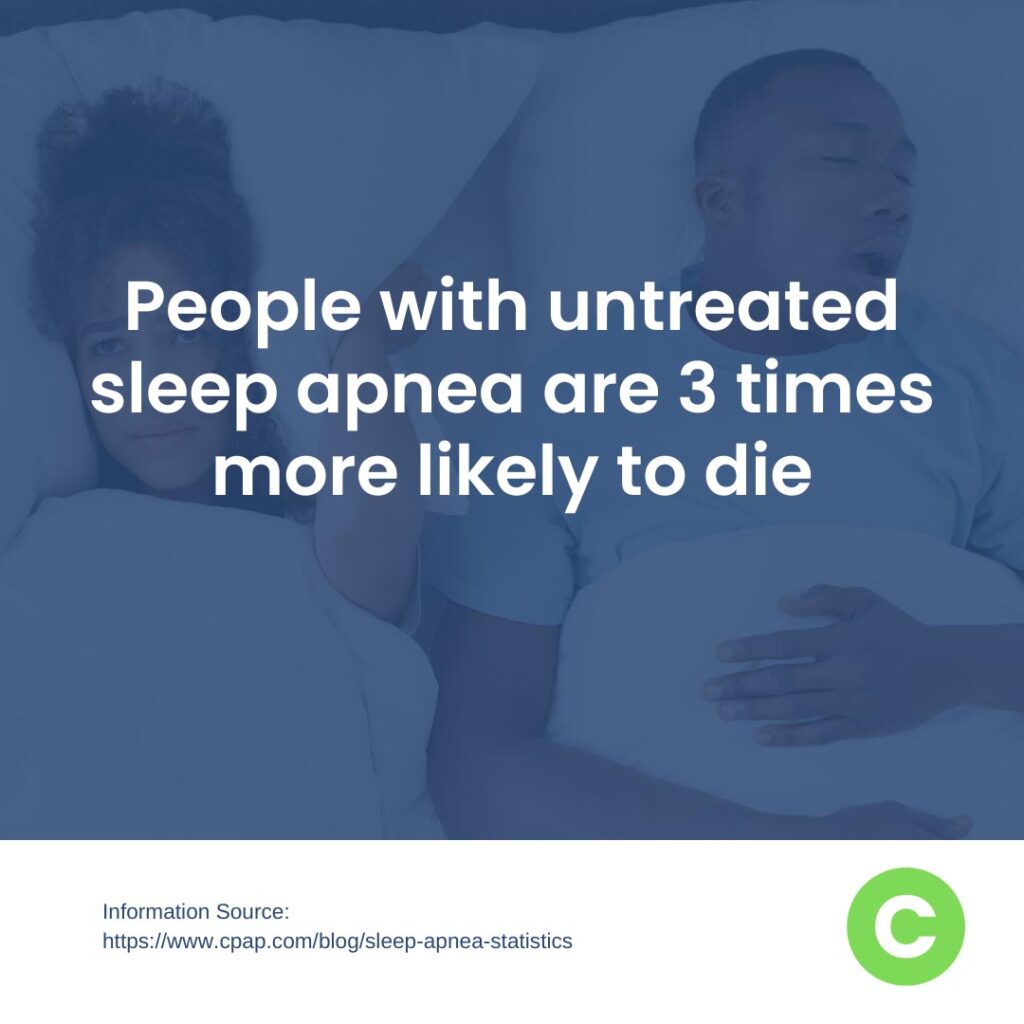
Cardiovascular Disease
- If you have OSA, you are twice as likely to have heart attacks.
- Having sleep apnea makes you 71% more likely to develop cardiovascular disease.
- You are also 48% more likely to develop coronary heart disease.
- Over half of people with Heart Failure have some form of sleep-disordered breathing.
- Up to 74% of people with A-Fib could have sleep apnea.
Related Reading: The Link Between Sleep Apnea and Heart Disease & A-Fib and Sleep Apnea
Diabetes
- Obstructive Sleep Apnea has been linked to insulin resistance.
- Up to 67% of people with OSA could have prediabetes.
- Having OSA significantly increases your risk of developing Type 2 Diabetes.
- Some scientists have estimated that up to 83% of people with Type 2 Diabetes have sleep apnea.
- While studying the immediate effects of CPAP, researchers found that untreated sleep apnea can cause blood sugar spikes within a couple of hours after falling asleep.
Related Reading: Understanding Sleep Apnea and Diabetes & Sleep Apnea Increases Your Risk for Diabetes
Poor Mental Health
- Recently, a team of scientists found that nearly 47% of people with sleep apnea also have some sort of mental health condition.
- One study found that 53.9% of people with OSA also experience anxiety.
- The same study also reported that 46.1% of people with OSA showed signs of depression.
Related Reading: Sleep Apnea and Anxiety & The Relationship Between Mental Health and Sleep
Brain Damage
- In one study, people with sleep apnea were 1.19 times more likely to experience traumatic brain injury (TBI).
- Affected people between the ages of 65 and 79 are 1.36 times more likely to experience a TBI.
- Severe sleep apnea is linked to higher rates of brain damage compared to mild sleep apnea.
- Brain damage caused by sleep apnea seems to improve after just three months of treatment with CPAP therapy.
Related Reading: Sleep Apnea and Brain Damage
Accidental Injuries
- A recent study found that having this condition increases your risk for accidental injury by more than 83%.
- People with this sleep apnea are 2.5 times more likely to get into a car accident.
- A 2004 study reported over 800,000 OSA-related car accidents during the year 2000 in the United States alone.
- Even with an undiagnosed case, you may be twice as likely to experience a workplace injury.
Related Reading: DOT Compliance Information
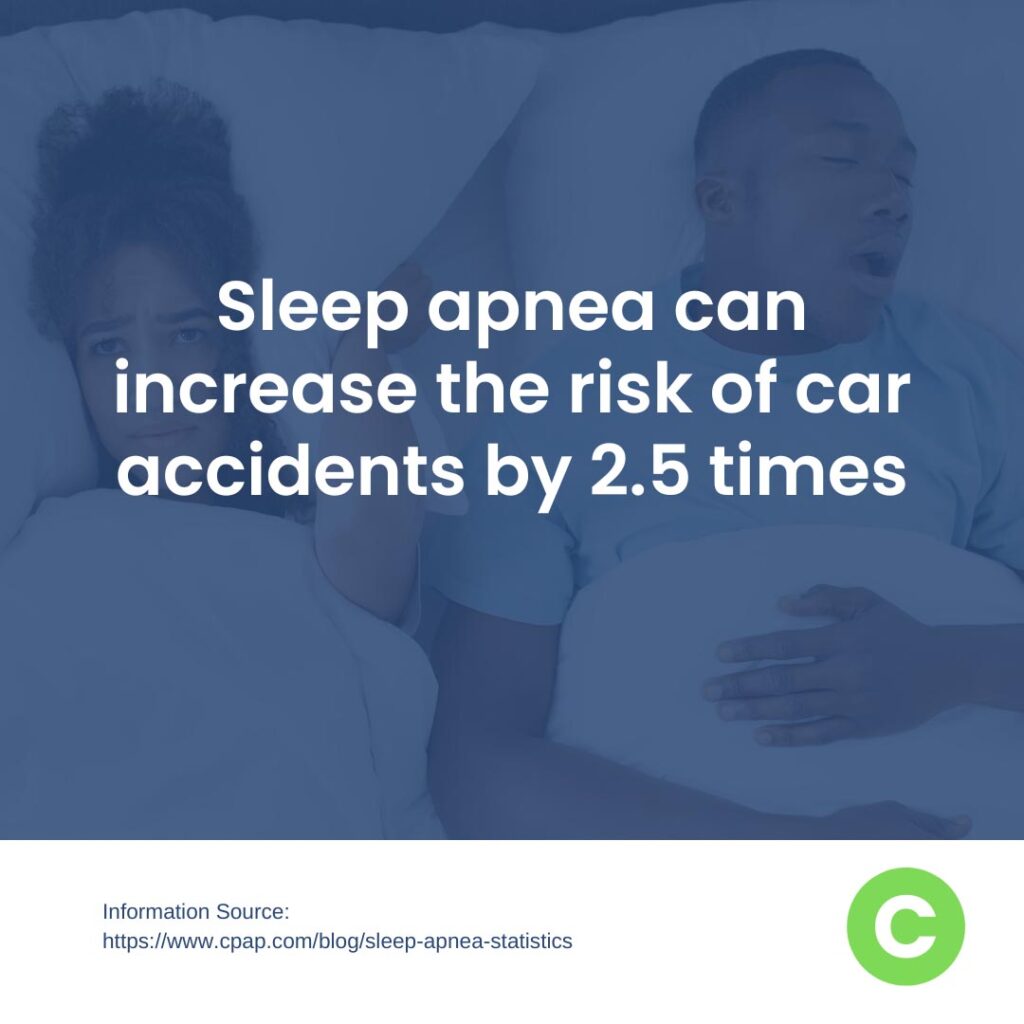
Sleep Apnea Treatment
Although Continuous Positive Airway Pressure is the go-to treatment, there are actually many ways to manage sleep apnea. Some solutions, such as Positional Therapy, can be done on your own and may be enough to improve mild cases. Some approaches may work better for a specific type of sleep apnea. If you have severe sleep apnea, your doctor may ask that you undergo multiple types of treatment.
Continuous Positive Airway Pressure (CPAP) Statistics
- While the exact amount is not known due to the number of people who quit CPAP therapy early, manufacturers have estimated that at least 8 million people sleep with a CPAP machine each night.
- It is estimated that between one-third and one-half of all people who start CPAP will quit within the first year.
- A 2014 scientific review found that CPAP-compliant people have an 80% success rate with their treatment.
- Ideally, healthcare providers want you to use your CPAP machine for at least 7 hours per night, but most insurance companies ask you to use it for a minimum of 4 hours a night, 21 nights a month.
- People who regularly sleep with their machine may have their risk of premature death decreased by as much as 61%. This 2022 study also projected that CPAP therapy decreases a person’s risk for heart failure by 77%.
- CPAP therapy could reduce your risk of getting into a car accident by 70% if you use your CPAP device for more than four hours each night.
- CPAP can significantly improve your quality of life due to better sleep. In one study, more than 90% of participants saw an improvement in at least one area of their lives.
- There are at least four other types of Positive Airway Pressure therapy– EPAP, APAP, BiPAP, and ASV.
Related Reading: Tips for Getting Used to CPAP, How to Fix CPAP Side Effects, Beginners Guide to CPAP, & Benefits of CPAP Therapy
Oral Appliance Therapy
- The compliance rate for oral appliances is estimated to be up to 90%, much higher than CPAP therapy.
- One study found that Mandibular Advancement Devices, a form of OAT, reduced the number of breathing events in 86% of participants.
- During the above study, 33% saw their AHI score cut in half.
Related Reading: What Is Oral Appliance Therapy?, Comparing CPAP and OAT, & Sleep Apnea Mouthguards
Surgery
- In the early 2000s, only 0.2% of people with OSA underwent surgery, but this has likely increased in recent years due to new advancements.
- Anatomical surgeries can be very effective in some cases. Uvulopalatopharyngoplasty (UPPP) has a success rate of more than 80% in individuals with a small soft palate.
- Not everyone is a good candidate for surgery. UPPP is only successful in 8% of obese patients with a large soft palate.
Related Reading: Understanding Sleep Apnea Surgery
Nerve Stimulators
- An estimated 30,000 people use nerve-stimulating implants to manage Obstructive Sleep Apnea.
- There are also nerve implants for Central Sleep Apnea, which stimulate the diaphragm.
- Implanting a Phrenic Nerve Stimulator reduced the number of CSA episodes by at least half in 51% of participants.
Related Reading: Best Devices to Treat Sleep Apnea
Positional Therapy
- A 20-year data analysis found that around 56% of people with OSA have Position-Dependent Obstructive Sleep Apnea (POSA), meaning they typically experience airway obstruction when sleeping in certain positions.
- Side sleeping reduces the severity of OSA significantly. One study found that PT improved the number of apnea-hypopnea events by 54%.
Related Reading: What Is Positional Therapy? & Best Sleeping Positions for Sleep Apnea
Lifestyle Changes
- Most health experts suggest making lifestyle changes to help manage sleep apnea, even when prescribing CPAP therapy.
- A 2015 study found that diet and exercise significantly reduce severity, from an average of 22 respiratory episodes per hour to 12.
- Studies show that quitting smoking reduces your risk and improves sleep quality.
Related Reading: Five Things You Can to Improve Sleep Apnea, Diet Tips for Sleep Apnea, & Weightloss with Sleep Apnea Treatment
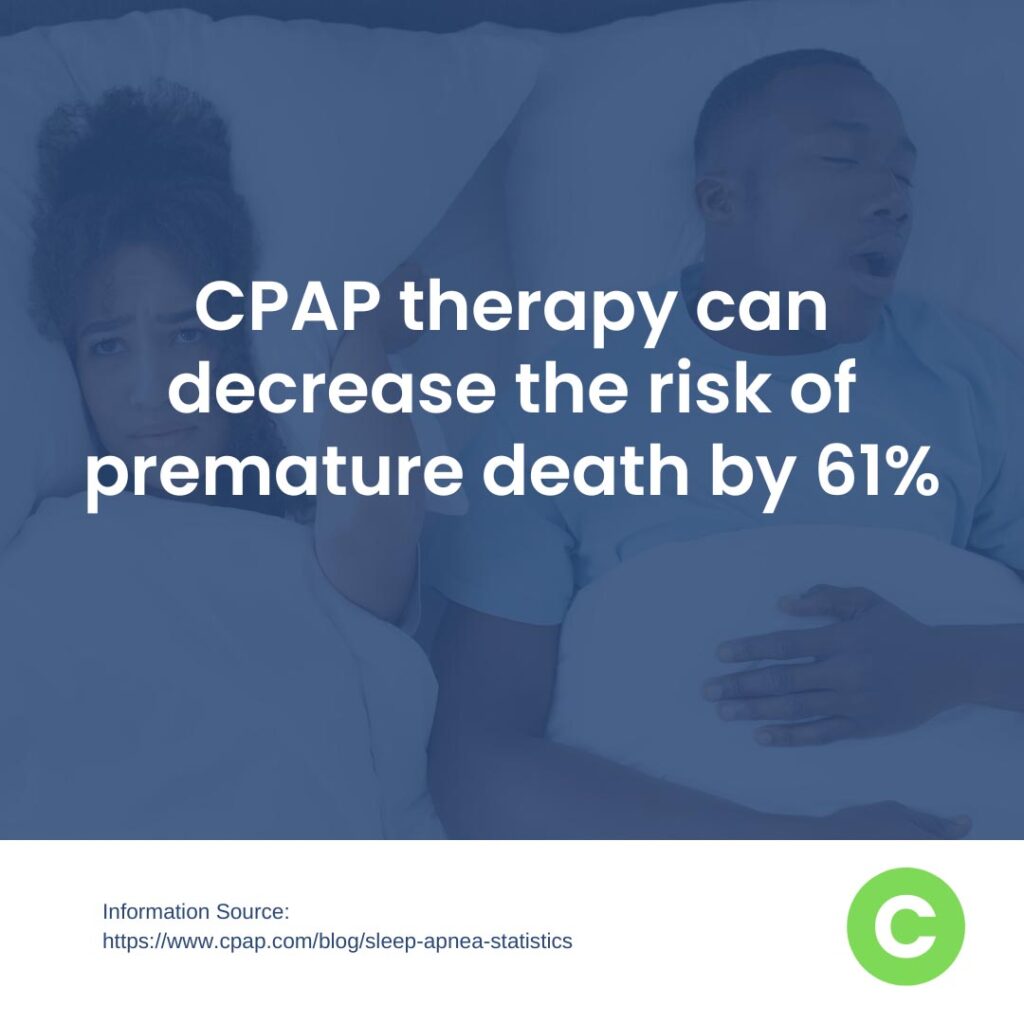
The Economic Impact of Sleep Apnea
Sleep-disordered breathing can come with some pretty costly effects. An obvious one is the cost of medical care for any secondary conditions that arise when a person does not receive treatment. But there are also economic issues related to accidents and productivity.
Cost
- One study found that adults with OSA spent about 1.8 times more on healthcare costs during the five years before their diagnosis.
- According to a 2004 report, treating all affected drivers would save $11.1 billion in collision costs every year.
- Experts believe the United States loses $149.6 billion yearly due to OSA alone.
- Scientists estimate that effectively treating OSA with CPAP therapy could save you between $2,700 and $5,200 per year compared to going untreated.
Related Reading: How Much Does a CPAP Machine Cost? & Insurance Coverage for Home Sleep Apnea Testing
Productivity
- In many cases, treating sleep apnea with CPAP therapy improves job productivity, reduces burnout, and improves cognitive stress.
- Affected adults may be more likely to experience job loss.
- Studies have found severe sleep apnea may impact work performance more than mild cases.
- Just one night on CPAP therapy can significantly improve your cognitive abilities necessary for work. These benefits get even better over time.
Related Reading: Working With Sleep Apnea
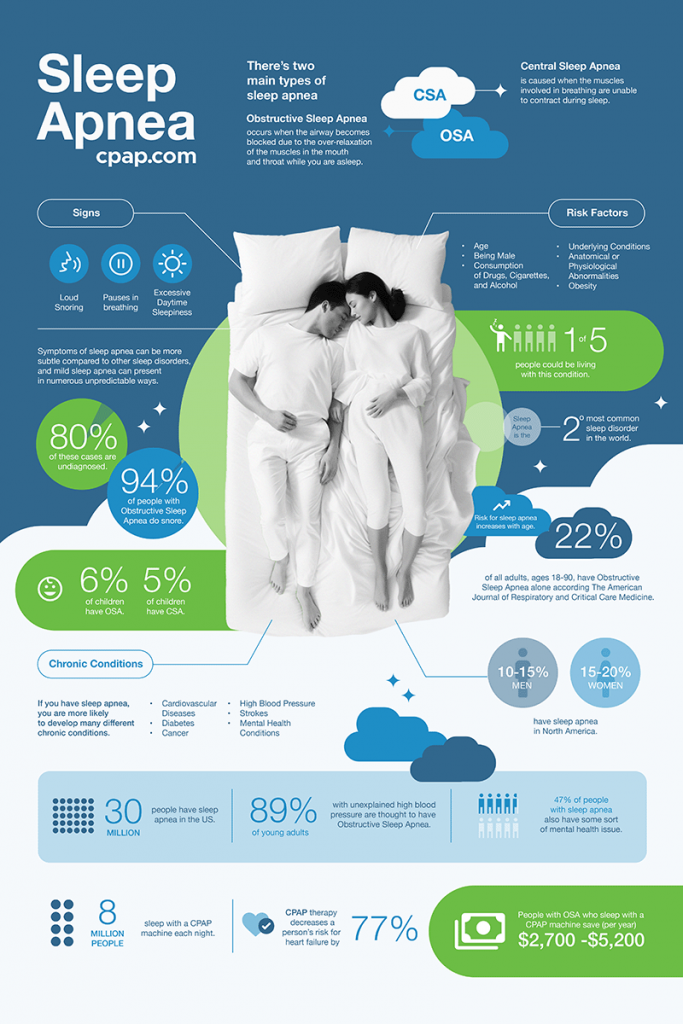
Frequently Asked Questions
How Many People Use CPAP?
While the exact amount is unknown due to the number of people who quit CPAP therapy early, manufacturers have estimated that at least 8 million people sleep with a CPAP machine each night.
How Many People Have Sleep Apnea?
Experts state that there are more than 936 million cases worldwide, many of which are undiagnosed. In the USA, health officials estimate that more than 30 million Americans are affected, over 9% of the population.
What Are the Different Types of Sleep Apnea?
There are three types of sleep apnea– Obstructive (OSA), Central (CSA), and Complex (CoSA). Obstructive is caused by airway blockages during sleep. CSA occurs due to an issue with the brain or respiratory muscles. CoSA arises when a person undergoing CPAP treatment for OSA also develops CSA.
Is Snoring Common in Sleep Apnea?
Snoring is common in some cases but not so much in others. For example, 94% of people with Obstructive Sleep Apnea snore, but it’s much less common for people with Central Sleep Apnea.
What Is the CPAP Success Rate?
If you use your CPAP machine regularly, CPAP therapy is successful in at least 80% of cases. However, many people struggle to remain CPAP-compliant, with at least a third of all CPAP owners quitting within months.
What Percentage of People Have Sleep Apnea?
The estimated percentage of adults with sleep apnea is between 10 and 15% worldwide. The percentage of childhood cases is far lower, with 1- 6% of children having OSA and 1-5% having CSA.
What Are the Treatment Options for Obstructive Sleep Apnea?
Treatment for OSA usually starts with CPAP therapy and lifestyle changes. However, there are alternative treatments as well, including Oral Appliance Therapy, Positional Therapy, surgery, and nerve implants.
How Is Severe Sleep Apnea Treated?
Doctors often prescribe CPAP therapy and lifestyle changes for anyone impacted by sleep apnea. However, more severe cases usually require high-pressure CPAP, which may also be paired with other treatment methods, such as surgery or Oral Appliance Therapy.
Final Thoughts
After reading through these sleep apnea statistics, you may wonder if you could be one of the millions of people with an undiagnosed case. If you or your partner suspect you have sleep-disordered breathing, we encourage you to speak with your doctor about completing an at-home sleep study.
For more sleep apnea facts, tips and tricks for treatment, and detailed guides for purchasing your perfect CPAP machine or CPAP mask, check out our blog!



